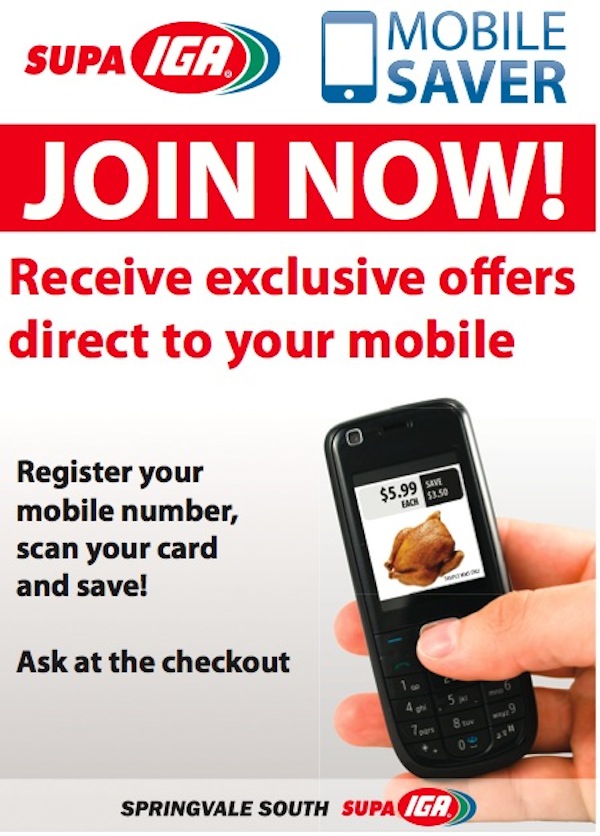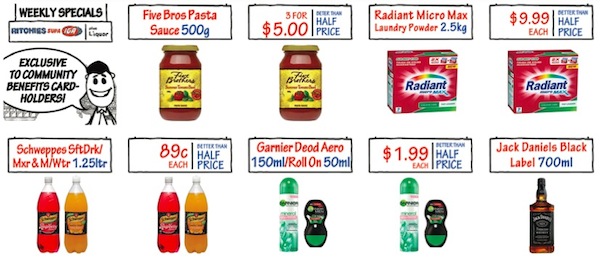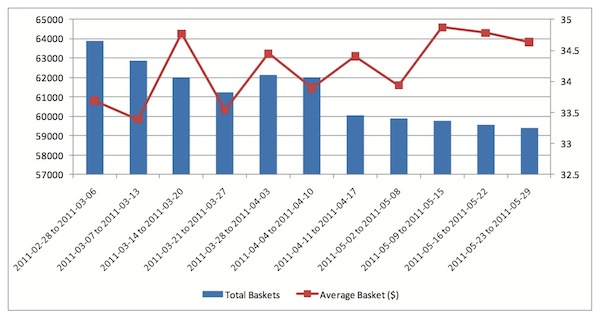How to mobilise – analysis of IGA’s mobile loyalty program
Share
Joe Barber lays bare Ritchies IGA’s mobile loyalty program to illustrate that in mobile marketing short-term campaigns are misguided – while this truly powerful program goes all but unnoticed.
Omni-channel retailing is an evolution of multichannel retailing, but enveloping the premise of a seamless singular strategy to the consumer experience through all shopping channels: mobile internet devices, computers, bricks and mortar, kiosks, television, catalogues and so on.
Over the last eight years, I have seen thousands of mobile implementations across five countries and am still bewildered by the inability of Australia’s major retailers to understand that the mobile is not just becoming an important adjunct to extend a media plan or tactical concept but, in fact, should be considered as the core upon which all extended media decisions are leveraged.
The majority of mobile executions in Australia, especially those formulated by agencies, are short-term tactical executions that fail to really deliver the massive potential mobile can deliver. Follow-up is limited, business process integration is all but ignored and the mobile is treated as little more than a ‘size challenged’ desktop. Treat mobile as just another digital channel and you’re destined to be overrun by those that acknowledge its power, understand its ability to create a true one-to-one relationship with a consumer and consider the impact of mobile as potentially significant as the deployment of a national interoperable EFTPOS network.
In some regards, my commentary is extremist to try and make a point. Unfortunately, the lack of true integration and creative adoption is more prevalent in Australia than in the US, the UK and many other countries; however, one implementation that started with a creative vision around five years ago is definitely worth analysis and is delivering some fascinating results. Despite winning an award, the program is all but under the radar from mainstream agencies and yet major brands and IGA are experiencing some astonishing results.
 Back in 2007, Fred Harrison (Ritchies IGA CEO), Richard Robinson (an independent mobile consultant and former CEO of Simon Richards) and Adam Trescowthick (investor and CEO of Third Screen) began discussions on the adoption of mobile within the framework of Harrison’s supermarket business. The discussions went beyond the ad hoc tactical execution and explored a core integration of mobile into business systems and Ritchies’ Community Benefits membership platform – some very insightful omni-channel retail thinking.
Back in 2007, Fred Harrison (Ritchies IGA CEO), Richard Robinson (an independent mobile consultant and former CEO of Simon Richards) and Adam Trescowthick (investor and CEO of Third Screen) began discussions on the adoption of mobile within the framework of Harrison’s supermarket business. The discussions went beyond the ad hoc tactical execution and explored a core integration of mobile into business systems and Ritchies’ Community Benefits membership platform – some very insightful omni-channel retail thinking.
The program concept was simple in principle: once a week as the impact of letterbox flyers begins to diminish, members of the program would receive a high-impact animated graphic along with text explaining six special, member- only offers – discounts, package deals and other incentives. Importantly, as I’ve expressed so many times with mobile, the program delivered a simple high-value benefit to the recipient. Harrison has always been regarded as a man looking to push the envelope and to challenge traditional thinking – this time to explore the untapped potential of mobile.
Some would say he’s a man with a vision and willingness to take calculated risks. After running some controlled, low-impact tests, the initial phases of the program showed some interesting signs. The trial stores attracted good membership numbers and the data collected revealed increasing visits and increasing spend – that’s more sales, more often.
By early 2010, after many revisions of thinking and process, the mobilisation of the membership program finally got the approval to roll out across all 70 Ritchies stores. Based on early trial results, it also saw support from IGA Distribution, the wholesale partner of the IGA retailers. Through a commitment from the Victorian merchandise manager, the program took on a new life, whereby IGA Distribution took over the purchasing and Third Screen managed the creation, distribution and member management of the program, leaving the retailers to do what they do best, which is sell merchandise.
Harrison says, “It has been an interesting ride exploring how to properly capitalise on mobile.” The original program had around 65,000 members with an early target to get to 100,000. Harrison adds, “A significant percentage of our overall sales are now from within the mobile program and we are able to get some great insight into our consumer behaviour from this key group of members of the program.” In time, the data will become critical to decision- making across the business.
Where this mobilisation initiative varies from traditional implementations is the massive commitment made to integrate the core transaction systems into the mobile architecture, creating a powerful closed loop system able to track and measure from the push messaging campaign right through to in-store purchases. The point of sales systems are ‘aware’ of memberships and those entitled to mobile exclusive offers, avoiding the challenge of linking the device and the transaction. This commitment is what now delivers IGA some insightful tracking and measurement results. There’s nothing anecdotal; it’s all real and auditable down to a single handset.
Distributor Metcash was supportive of the mobile program and became more involved, delivering some immediate benefits in the ability to assist retailers to talk directly to their wide customer base. The unique structure of the Metcash and IGA store network has traditionally meant that Metcash does not interact directly with the end user – the customer – but the mobile program gives it the opportunity in association with its retailer base.
Metcash and Third Screen are now in the process of rolling out the program to all interested IGA stores. Other retailers outside of the Ritchies IGA network are also coming on board. There are a number of store owners working with Third Screen, which already has over 100,000 members and a new revised program goal to have 250,000 by the end of the calendar year.
The membership of the mobile benefits program is constantly monitored and within the past year it has seen a growth in what is referred to as the ‘cheer squad’ group: those that are 100% committed to the cause. This group is now around 20% of the total membership and includes 70% of the total spend of the program.

Closely following the ‘cheer squad’ are the ‘paid-up members’, and there has been an impressive movement from the ‘supporter’ group to the ‘paid-up members’ over the past 12 months, which has also seen the percentage of spend in this group increase by over 2%.
The ‘supporters’ group and the ‘uncommitted’ group now account for 63% of the membership base, which is down from 69% a year ago.
As mentioned above, the program is based on a weekly MMS offer being sent to the opt-in database, making it unique in the market. The MMS allows the suppliers and retailers to deliver a rich media message directly to the member’s phone. The message is typically sent as an animated gif with the initial slide indicating which IGA store the message is coming from.
The message includes a unique offer from each of the banner retailers, so the store owners have the opportunity to create an offer they believe will generate sales. In addition, there are four or five offers organised by Metcash directly with the supplier base. The offers are across all categories and are usually extremely well-priced.

Has it registered yet? Not only is the mobilisation program deeply integrated with the transaction systems, integrated into the marketing, dovetailing with the letterbox flyers and delivering the consumer real benefits and savings, but it’s hyper-local. The complex message management system built by Third Screen in conjunction with Metcash allows for automated local specials to be inserted and managed right down to store level. In fact, the system can enable the tailoring of offers directly with suppliers targeting specific groups of members or even an individual member based on transaction history. Now that’s powerful.
As the program is attached to an existing loyalty program within the store, or a custom created and managed program if one doesn’t exist, all that the customer need do is purchase the promoted products, swipe their card and the reduced price will automatically be deducted – and this is all automated through the cashier.
Third Screen has integrated the program across all the IT platforms within the store network and creates end user reports for the participants. Ongoing analysis of the data is showing significant increases in sales for the promoted items. A typical weekly report is shown below demonstrating the value in the data collected. This report shows the effectiveness of the mobile offer (the red spires), as against the previous six months of sales of the product within the membership database. Yes, by integrating the systems with the membership system, it’s possible to track historical sales against the impact of the mobile campaign. For the data analyst, that’s terabytes of data and analysis heaven!

The seven-day spikes within the above graph represent catalogue promotion periods for this product – which are over a seven-day period as against the five-day promotional period for the mobile offers. As a result of the reporting, the store owners are also learning more and more about their customers and the Metcash team is learning more about which offers work best within the mobile space and for the membership. That’s almost a three times greater impact on sales than for the same product promoted through catalogues. It’s no surprise that brands are now working directly with the Metcash team to drive sales.
The store network joins the program free of charge with the key commitment that they merchandise the offers in-store as requested to provide a unified national integrated and uniform program. Point of sale materials act as advertising for the program in-store and underwrite the ongoing growth of the program for all banner groups.
As the database of members grows, offers are now being created based on previous shopping habits. Third Screen is able to identify a group of shoppers – be that at a category level (e.g. liquor) or at a product level (e.g. dog food) and the Metcash team are then able to work with the supplier base to deliver an offer that is relevant and targeted to the members who will respond. The advantages of this are obvious in creating better offers for the membership. Plus, reducing the target audience gives a significant lift in the ROI for the supplier.
The goal of the program is to ensure that the membership database is fresh and shopping with IGA as much as possible. It plays straight to the heart of all marketing and promotional objectives: more revenue. Research undertaken on the Ritchies IGA database in May 2012 showed that for the previous three months (February to April):
- up to 40% of the membership shopped on average weekly,
- up to 67% shopped on average monthly, and
- over 96% of the members shopped at least once in the three- month period.
Where the data analysis shows that members have not shopped, a program has been created whereby the member is targeted with an offer to entice them back in-store and that, if this offers elicits no response, a phone call is made and if the member wishes to opt out they are opted out.
The rules dealing with how lapsed shoppers are managed are constantly being reviewed, with the overall goal being to ensure that the membership database on any given day is as fresh as possible – this leads to higher redemption rates and better ROI for the participants.
This is an incredible focus on the most important thing in business: the customer. The efforts to re-engage and deliver extra special benefits leading to a direct phone call is a level of customer focus that so many have forgotten and ignore by hiding behind digital systems. Without digressing too far from mobile, this level of core philosophy weaved through a new technology is seemingly obvious. Think about how many lists and loyalty programs you’ve joined and in two years have never been ‘touched’ regardless of being a regular shopper or not having returned for two years. Maybe some mass mailings or email spam, but personal targeted SMS/MMS messages and then a phone call? Imagine how important and special as a customer that would make you feel. Expensive maybe, but think of the viral impact and word of mouth. That’s something I’d tweet about and suddenly there’s an extra 3000 people hearing about the incredible personal attention given by IGA.
These promotions are aimed at engaging with the membership at more than price and product. There are many opportunities for free-thinking suppliers to engage with the membership and generate interesting outcomes; it’s not always just about increasing sales. For me, a mobile evangelist, the vision of Harrison and Trescowthick combined with the Metcash IGA team has created one of the best examples of how to capitalise on mobile by integrating into foundation systems, linking with transactional data and analysing in a manner that challenges even the most seasoned retail analyst right down to full localisation. When you think of SoLoMo (social, local, mobile) or omni-channel retail, then here is an outstanding case study of persistence, innovation and success. Thanks to Fred Harrison of Ritchies IGA for sharing the data.
As a final thought and now my chance to dream… imagine if this data were combined and linked to non-grocery behavioural data, such as clothing or general household items. Imagine being able to target consumers based on their local shopping area, their food buying habits and the types of clothing they enjoy, to target shoes or homewares that suit this specific demographic and present a high-value offer to a well-targeted audience. The ROI would be staggering and the shared insight between participants would generate fear among the most seasoned retailer if they weren’t participating. But that bigger picture mobilisation thinking is still some time away and the innovation shown originally by Harrison unfortunately is not commonplace and usually stifled anyway by the external suppliers who are engaged and meant to be creating and designing the innovation.















